 So on Sunday I attended a small one day tournament with my Blades of Khorne army at Bristol Independent Gaming (BiG). This was a friendly event organised by Jim who runs BiG. Overall I had quite an enjoyable if long day, frustratingly I came rock bottom out of the 13 players and was constantly hampered by what I consider some of the inherent weakness in Blades of Khorne lists (in addition to Mystical terrain).
So on Sunday I attended a small one day tournament with my Blades of Khorne army at Bristol Independent Gaming (BiG). This was a friendly event organised by Jim who runs BiG. Overall I had quite an enjoyable if long day, frustratingly I came rock bottom out of the 13 players and was constantly hampered by what I consider some of the inherent weakness in Blades of Khorne lists (in addition to Mystical terrain).
What I’m hoping to do in this post is to roughly outline my observations with the games I played, the event in general and what changes I’d make to my 1000 point list if I were to attend a similar event. Hopefully this comes across fairly objectively rather than me complaining that I lost!
I’ve never been to BiG before and was quite impressed. All the tables had battle mats and a pretty reasonable selection of scenery placed on them in various forms. The tables were all 6×4 but cleverly has a 2×4 board placed on one end to “crop” them to the 4×4 we would play on.
The event followed a slightly different format to other AoS one-dayers in that we were playing four one and a half hour games, pretty much back to back, rather than three with rest breaks. Because we had an uneven number of players the bottom table was a three-way game. If I had to single out one issue with the event, it would be the three-way game. The issue is that you can only have one winner and the Matched Play battleplans from the Generals Handbook, really don’t cater for three-players. The two games I played this meant we lost 20~25 minutes at the beginning or each whilst we debated the best way to handle scoring and deployment. I’ve played quite a few multiplayer games now and they need at least 50% more time than a two player at equivalent points so anybody playing on this table was going to suffer in the overall competition.
Game One – Stormcast
I think this would be the game I’d pick as the most enjoyable from the day – and ironically I took no photos of it. My opponents’ army was really nicely balanced, with a smattering of shooting and some very solid units as you’d expect from Stormcast. For me the game started off badly with a piece of Mystical terrain locking my unit of ten Blood Warriors in place for the first turn. I managed to deny him a major win, but struggled to remove any full units due to the usual amazing Stormcast armour saves and my lack of rend. As I’ve found in the past, lack of mobility means you end up hitting the enemy a unit at a time rather than as a big solid block.
One thing that this game did highlight was that if you’ve models not yet deployed, you effectively deny those kill points to your opponent. This basically happened with a unit of Vanguard, although I will admit that there was little chance of me taking them off the board if they had arrived.
Game Two – Iron Guts vs Stormcast
My first three-way game, which took 25 minutes before we actually started the first turn – we were playing Border-War where each of the four objectives were worth differing points based on if it’s in your or your opponent’s deployment zone…
Overall I was fairly happy with how the game went, the Iron Guts split their army to deal with my army and the Stormcast. Where the issue came was that we were playing on a 6×4 and my deployment was a tiny 12″ x 18″ area in one corner with a piece of Mystical Terrain in it, which my unit of five Blood Warriors got stuck on the first turn. This meant that I really struggled to get the army moving until turn 3 and that was the last turn. In truth, we really needed an extra hour to cater for the initially lost time and to play to turn five – and we actually overran by quarter of an hour into lunch.
Victory went to the Iron Guts player although I was technically second based on VP’s.
Game Three – Sylvaneth
For me this was a bit of an odd game. I actually quite enjoyed it and my opponent was a really good sport and was offering me bits of advice when it came to things like charging through Deadly terrain (and Sylvaneth woods), so I learned quite a lot. However, I would say this was probably the worst game in the sense that my opponent’s army was very difficult to interact with, composing of a Branchwych, Treelord, unit of Dryads, unit of Tree Revenants, Scythe wielding Kurnoth Hunters, a Balewind Vortex and a battalion.
This was the only game I played all day where I got all of my turns in and each of my opponents turn consisted of him firing off one or two area of effect mortal wound spells from the top of a Balewind Vortex. This saw me lose most of my characters to magic by turn 3 with absolutely nothing I could do (although the Bloodsecrator survived this onslaught). Due to the terrain, the Balewind actually blocked me getting to his Treelord as it filled the only gap available. My opponent won a minor victory purely based on the number of units destroyed as I solidly held half the objectives. A unit of Tree Revenants were also kept off board preventing a few more kill points.
Game Four – Kharadron vs Stormcast
And with my last loss I was back on the three-way game with Gift from the Heavens. The Stormcast army was the same one I faced in Game two. Having never faced Kharadron before this was always going to be a learning curve and their bias for anti-hero shooting would make it a painful one too. Rather than a 6×4 we played on a 4×4 as it should speed things up – sadly this meant the deployment area became 12″ x 12″, far too small for the models I actually had.
The Kharadron army consisted of two Frigates, two Arkanaut Companies and an Aether Khemist. As I’ve said before, although legitimate, I’m really not a fan of double Behemoth armies at this point size. I actually felt the army didn’t do as much as it could have at the points value and think I’d have swapped one Frigate for a unit of Thunderers.
The Stormcast got the brunt of Khrardron firepower as I waddled up the table although I had my Bloodsecrator sniped off first turn and my Exalted Deathbringer and Mighty Lord went on turns two and three. As with the other three-way game we only got to turn three – so basically when I got the bulk of my army in place.
As expected the shooting was horrendous and an Arkanaut Company easily deleted a unit of Retributors in one turn. Unsurprisingly the Kharadron player won based on comet control. One thing that I did pick up for the future, is once you’ve dropped your Arkanaut company off – fly your Skyvessel away from them! I was able to charge into the Arkanaut company with my Mighty Lord and Exalted Deathbringer and then wheel round into a Frigate, avoiding them dropping bombs on my head!
One tweak we made to the Battleplan was to add a third comet (givin one per player) which landed in the middle of the battlefield but then scattered using a 40k scatter dice 2D6″ away. The three of us really enjoyed this random element and think that adding a D6″ scatter for the regular Battleplan would make it a lot more interesting.
Summary – What I’d change in my Blades of Khorne List
It would be very easy for me to simply shoulder the blame onto everything else. But I did make some fundamental errors in my army list to begin with, so I’ll go over them first and then surmise what other things I struggled with during the day.
My army list didn’t have enough thought put into it. With the Khorgorath going up by 20 points, I slotted in an Exalted Deathbringer to fill the 80 point void (as I was closer to having one painted). What I didn’t think about is that it meant I had 420 points worth of heroes in my army with only 21 wounds between them. This gave my opponents free kill points throughout all of my games for very little benefit for me. Although the Mighty Lord is a fantastic unit with a very good Command Ability, I feel that with the massive increase in sniping available to the vast majority of armies he doesn’t have enough wounds to let him last into combat for this sized game.
Movement has always been an issue with Khorne and as bitter as this will make me sound, the new Blades of Khorne Battletome only applies a sticking plaster to this problem, the Stormcast Eternals Battletome granted celestial realm deployment across the entire army. What we actually needed was the 1-point Blood Tithe ability to grant D6″ movement for all unengaged units. This would have gone a long way to fixing one of the biggest problems Khorne armies have and wouldn’t be too overpowered (Destruction get this as an army-wide Trait from turn one). In the future I may consider adding in Skullcrushers into my Vanguard size army but they’re not cheap.
The new Battletome also screwed us over when it comes to anti-magic as my third game quite spectacularly displayed. Khorne only has three heroes with a single unbind each now – not particularly impressive for a God that hates magic. And although I appreciate there are a few artefacts to help that’s not really representative of how the army is portrayed, the Bloodsecrator forcing re-rolls is also not that great for those low casting value spells either – especially when you’ve got a +1 to casting from a Balewind or similar.
Oddly the last thing I felt I did wrong was to include quite a lot of models – I took 29 models in total and generally found they kept getting in each other’s way. Turn one is nearly always going to be running – so you had the units at the front not running very far (or being locked due to Mystical terrain) and basically blocking the movement of units behind. Not ideal really especially when coupled with the frustratingly small deployment zones on the three-way games.
Summary
Although I enjoyed the event, I felt that once I lost my first game and went on the multiplayer table, I was destined never to do particularly well. If you speak to any Khorne (or Nurgle) player the biggest issue that the army has is sheer lack of movement. You either need to pay a premium for faster units (Skullcrushers) or use shenanigans (Battalions or Sayl). At 1000 points, you can’t really bring many shenanigans to bear. Which means if you’re lucky you’ll get some of your army into combat turn two and some more in turn three with the rest coming along on turn four. A three-player game, even at 1000 points, was never going to get many turns in, which meant that I spent most of those games running models and removing casualties. Now I’m not going to pretend that I’d have done better if I hadn’t gone on that table – as I’ve outlined I had a far from optimal list.
In comparison to my last tournament in August, the overall “meta” has indeed changed to one that employs character sniping in abundance. For an army that relies on synergies from characters and doesn’t have the same character sniping in return, it does very much feel that Khorne really struggles to be competitive at this points size. Now I’m not saying that Blades of Khorne isn’t competitive – I’m hoping my 2000 point army for Bristol Smash won’t be another wooden spooner, but I think for 1000 points it currently lacks the necessary components in comparison to similar armies.
I do think the Balewind Vortex needs looking at – it wrecked my army with the combination of spells used and meant I was unable to interact with it at all. Please don’t think it’s me being bitter – but there needs to be some way to counter this that’s available for all armies. Clarification needs to be made on if you can dismiss and resummon it and claiming kill points for it needs to be considered. This leads onto my other gripe about kill points for units not brought onto the battlefield, be they in another plane or something summoned.
As a final word, I really hope Games Workshop sends some love to Grand Alliances other than Order. There were at least 6 Order armies (4 of which were Stormcast), which is a massive shame and made things a little mono-tone.
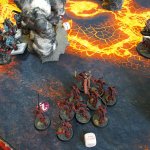
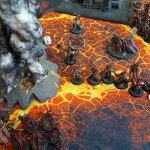
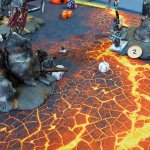
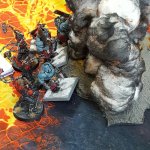
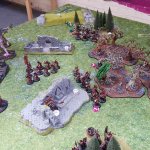
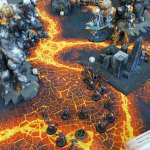
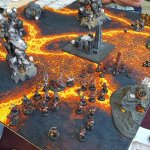
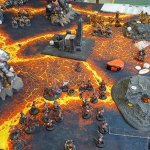
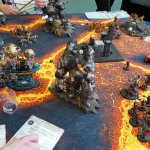
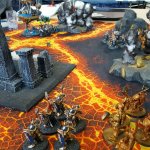

1 thought on “Blades of Khorne – first tournament outing at BiG”